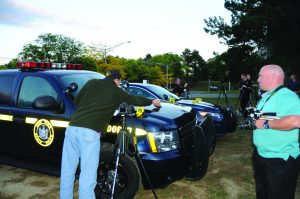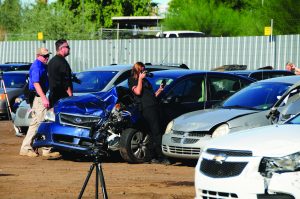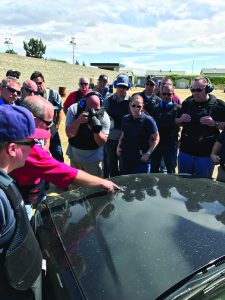Training has always been a key part of the law enforcement career continuum. In order to effectively police a population, officers need to stay informed on changes in the law, in technology, in methodology, and in criminals and crime, among other things.
According to data from the Bureau of Justice Statistics (BJS), from 2011 to 2013 (the last year for which federal data were available), about 135,000 (45,000 per year) entry-level officers entered basic training programs at 664 law enforcement training academies. Training covers a wide range of subjects, from report writing to defensive tactics to driving.1
In a sign of the times, community-oriented policing and related subjects are gaining prevalence, according to the BJS report. In 2013, 97 percent of academies provided training in this area, up from 92 percent in 2006. In 2013, recruits were required to complete an average of more than 40 hours of training in this area.2
There is a full spectrum of training available to law enforcement agencies at any given time, and, increasingly, many providers offer online learning options to supplement or replace in-person training. However, the online world appears to be changing more than just the training environment—it is changing the training itself.
“I believe [training is] more important now than it was ever before due to social media,” said Bruce Herring, assistant director of training at the Institute of Police Technology and Management, a training organization based in Jacksonville, Florida. “There is a lot of access to what officers do on a minute-to-minute basis. Keeping up with new laws and new trends is key.”3
Follow the Evidence

At Command Presence, a private training agency headquartered in Brunswick, Georgia, instructors are offering a suite of training opportunities, all of which are grounded in research and law enforcement data.
“We’re an evidence-based training company,” said John Bostain, a former police officer and SWAT team member and now the president and lead trainer of Command Presence. “The research and the data are the basis of everything we do. We look at the data, and we develop specific mitigation strategies.”4
How this translates for agencies is that trainees gain new expertise in the areas where they and their colleagues most need it, according to statistics.
“The term ‘officer safety’ is thrown around a lot, but what are the real threats?” Bostain explains. “They’re not what people think. For example, the top cause of injury is the way we operate our vehicles, and they happen when we go on relatively minor service calls.”5
There are plenty of assumptions about the unique work that law enforcement professionals do. More than a few of those assumptions come from within the community.
Command Presence frequently tailors community-oriented training programs based on a given agency’s situation. The only private training agency with two recipients of the International Law Enforcement Educators and Trainers Association Trainer of the Year award on its staff, Command Presence aims to empower officers and maximize their safety while helping them become more knowledgeable about the people they are serving and the situations in which they serve. In Bostain’s philosophy, these two concepts are far from mutually exclusive.
 |
 |
 |
| Students in Institute of Police Technology and Management courses are trained in specialized skills such as digital photography for traffic crash investigators (left, Sewell, NJ; center, Albany, NY) and shooting incident reconstructions and photography (right, West Sacramento, CA). Photos by Donald Barker, IPTM. | ||
“We’re increasing officer safety while increasing the quality of contacts with the community,” Bostain said. “Some people think the first has to somehow come at the detriment of the second, but that’s not the case. Respect is an officer safety issue… It is about looking at people as people and not as objects.” Simply put, Bostain half-jokes that the agency’s tactics are designed to help officers “stay safe and stay off YouTube.”6
That philosophy is more formally detailed in what Command Presence instructors call the Think CLEAR approach, a partial acronym for addressing issues around communication, legal authority, emotional intelligence, adaptive decision-making, and respect.
As the backbone for much of the Command Presence training programs, Think CLEAR seems to be making a clear impact. “The Think CLEAR approach is remarkable to say the least,” wrote Captain Scott Woodell, a recent trainee and director of training at the Georgia State Patrol. “Communication is the cornerstone of what we do and it is more important in today’s environment than ever before… The program curriculum and structure is outstanding. The course content is delivered in a format that keeps everyone engaged, [and] engagement equals knowledge retention. I cannot speak highly enough of this program and the benefits it will have on the officers and administrators attending. On point and on time for the modern age.”7
A One-Stop Shop

Even as community policing occupies a larger slice of the training pie graph, plenty of other training needs remain. Many training organizations can help, but the Institute of Police Technology and Management is in an unusual position to do so because it offers several kinds of training under one metaphorical roof.
“A lot of training places center around one area of law enforcement training, be it forensics, or management, or what have you,” Herring said. “But we’re centered around any kind of training that law enforcement needs. We’re a full-service organization.”8
Some of the subjects the Institute of Police Technology and Management provides courses on are traffic, forensics, criminal interactions, and management. But agencies don’t receive cookie-cutter courses. Agency leaders can collaborate with the institute’s course designers and instructors to modify a given course or courses based on the agency’s needs.
“We customize the courses. It’s all customizable,” Herring said. “They call and say ‘Hey, we like this course but we need this and that added.’ We get with our experts, and we customize from there.”9
The Institute of Police Technology and Management, which now does about 10 percent of its instruction online, has approximately 200 instructors on its rolls, from active officers to retired federal, state, and local police. They offer training across the United States and have also gone overseas to nations including Saudi Arabia, Malaysia, and Indonesia.
“These Skills Are Very Tricky”

When training occurs, it can be good to know you are in expert hands. That’s especially relevant when studying a highly technical side of the field.
One organization that can meet that need is the National Forensic Science Technology Center (NFSTC) in Largo, Florida. The NFSTC has been in existence since 1995, when it was established with help from the National Institute of Justice.
These days, according to Chris Vivian, the center’s director of communications, the center and its training mission are more complex—and important—than ever. “Some of these skills are very tricky,” she said. “It’s always changing. So what training does is it creates a consistent base of knowledge. Consistency is very important.”10
In a mix of online and hands-on environments, NFSTC instructors provide intensive courses in site exploitation and customizable scenario training, as well as online courses on topics like digital crime scene photography and DNA analysis.
Crime scene investigation (CSI) is a popular subject, as is a new area—digital forensics. The center just launched an online CSI assessment tool at www.csi-skills.com, a kind of simulator that guides users through a crime scene investigation and then grades their performance. A free online demonstration is available.
“We started off serving the laboratory, but now we broadened our training to include CSI,” Vivian said. “Because forensics really starts at the crime scene.”11
From basic skills like photography to more technical ones, staying on top of new tools without losing the old ones is key for all law enforcement professionals—and training is what helps accomplish that. “I think it’s important to keep a consistent focus on these skills because they’re perishable skills,” Vivian said. “If you don’t practice some of these skills, such as photography, you can lose them.”12
From tactical training to community policing to specialized skills and more, the field of law enforcement training abounds with options for law enforcement agencies of all types and sizes.
Notes:
1U.S. Bureau of Justice Statistics, State and Local Law Enforcement Training Academies, 2006, 2013 (2016), 1.
2Ibid., 7.
3Bruce Herring (assistant director of training, Institute of Police Technology and Management), telephone interview, July 24, 2017.
4John Bostain (president and lead trainer, Command Presence), telephone interview, July 20, 2017.
5Ibid.
6Ibid.
7Scott Woodell (captain, director of training, Georgia State Patrol), 2017.
8Herring, telephone interview, July 24, 2017.
9Ibid.
10Chris Vivian (director of communications, National Forensic Science Technology Center), telephone interview, July 24, 2017.
11Ibid.
12Ibid.
Please cite as
Scott Harris, “Training Programs Adapt to Modern Needs,” Product Feature, The Police Chief 79, no. 9 (September 2017): 68–70.
PRODUCT FEATURE TRAINING PROGRAM PROVIDERS
Command Presence Training Associates
Fair and Impartial Policing
FBI-LEEDA
IACP Leadership in Police Organizations
IACP Women’s Leadership Institute
Institute of Police Technology and Management
National Forensic Science Technology Center
Northwestern University Center for Public Safety
Sirchie—Education and Training Division
Southern Police Institute


